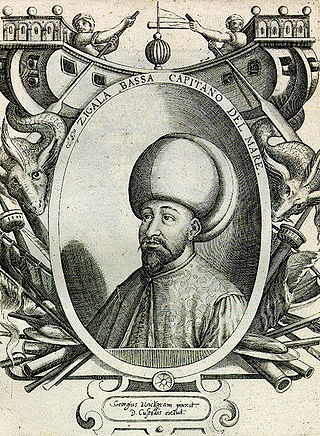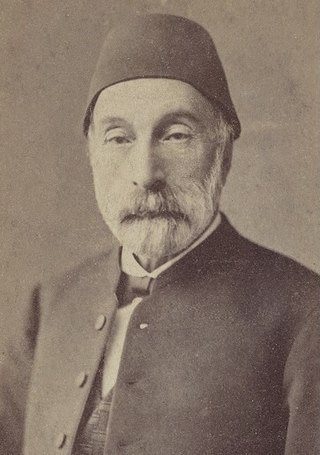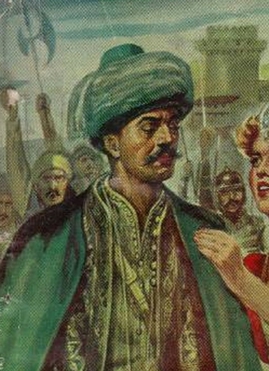
Mehmed III was the sultan of the Ottoman Empire from 1595 until his death in 1603. Mehmed was known for ordering the execution of his brothers and leading the army in the Long Turkish War, during which the Ottoman army was victorious at the decisive Battle of Keresztes. This victory was however undermined by some military losses such as in Gyor and Nikopol. He also ordered the successful quelling of the Jelali rebellions. The sultan also communicated with the court of Elizabeth I on the grounds of stronger commercial relations and in the hopes of England to ally with the Ottomans against the Spanish.
Grand vizier was the title of the effective head of government of many sovereign states in the Islamic world. It was first held by officials in the later Abbasid Caliphate. It was then held in the Ottoman Empire, the Mughal Empire, the Sokoto Caliphate, the Safavid Empire and Cherifian Empire of Morocco. In the Ottoman Empire, the grand vizier held the imperial seal and could convene all other viziers to attend to affairs of the state; the viziers in conference were called "Kubbealtı viziers" in reference to their meeting place, the Kubbealtı in Topkapı Palace. His offices were located at the Sublime Porte. Today, the Prime Minister of Pakistan is referred to in Urdu as Wazir-e-azam, which translates literally to grand vizier.

Mehmed Said Pasha, also known as Küçük Said Pasha or Şapur Çelebi or in his youth as Mabeyn Başkatibi Said Bey, was an Ottoman monarchist, senator, statesman and editor of the Turkish newspaper Jerid-i-Havadis. He served as grand vizier for nine years in total, seven times during the reign of Abdul Hamid II and twice during the Second Constitutional Monarchy. He was known for his opposition to the extension of foreign influence in the Ottoman Empire. He was among the statesmen who were disliked by the Committee of Union and Progress (CUP). However in his last two grand vizierships, Said Pasha was supported by the CUP in the Chamber of Deputies, and his last grand vizierate ended in 1912 with a military memorandum against the Unionists.

Cezayirli Gazi Hasan Pasha or Hasan Pasha of Algiers was an Ottoman Grand Admiral (1770–90), Grand Vizier (1790), and general in the late 18th century.
Damat Ibrahim Pasha was an Ottoman military commander and statesman who held the office of grand vizier three times (the first time from 4 April to 27 October 1596; the second time from 5 December 1596 to 3 November 1597; and for the third and last time, from 6 January 1599 to 10 July 1601. He is known as the conqueror of Kanije.

"Öküz" Mehmed Pasha, also known as Kara Mehmed Pasha or "Kul Kıran" Mehmed Pasha, was an Ottoman statesman, administrator and military figure of the early 17th century who held the office of Grand Vizier twice, the first time from 17 October 1614 to 17 November 1616 and the second time from 18 January 1619 to 23 December 1619. He was also governor of Egypt from 1607 to 1611. Okuz Mehmed's nickname "Kul Kiran" (slavebreaker) came from his success in crushing the mutiny in Egypt during the early 1600s.

Cığalazade Yusuf Sinan Pasha, his epithet meaning "son of Cicala", was an Ottoman Italian statesman who held the office of Grand Vizier for forty days between 27 October to 5 December 1596, during the reign of Mehmed III. He was also a Kapudan Pasha as well as a military general. He was one of the most capable statesmen of the Ottoman Classical Age, having contributed to the eastwards expansion of the empire at the expense of Persia and successfully defended Ottoman Hungary from Habsburg invasion. However, because of court intricacies, he resigned from the Vizierate after just over a month in office.
Çandarlı Kara Halil Hayreddin Pasha was the first Grand Vizier of Murad I's reign. He was also technically the first in Ottoman history who held the title "Grand Vizier", the first who had a military background, and the first member of the illustrious Çandarlı family to hold high office. His family was to mark the rise of the Ottoman Empire between 1360 and 1450. He was a successful commander, setting the precedent for centuries of Ottoman presence in Albania after his victory at the Battle of Savra.

The Battle of Focșani took place during the Russo-Turkish War (1787–1792) on 1 August 1789 between the Ottoman Empire and the alliance of the Russian Empire and the Habsburg monarchy near Focșani, Moldavia. The Russians were led by Alexander Suvorov, the Austrians by Prince Josias of Coburg, and the Ottomans by Grand Vizier Koca Yusuf Pasha.

Mehmed Esad Saffet Pasha, also known as Saffet Pasha (1814–1883), was an Ottoman statesman, diplomat and reformer, who served as the Grand Vizier of the Ottoman Empire during the reign of Abdul Hamid II. He was a representative of the Ottoman Empire, alongside Sadullah Pasha at the Congress of Berlin.

Silahdar Damat Ali Pasha, also called Silahdar Ali Pasha, was an Ottoman general and Grand Vizier. His epithet silahdar means arms-bearer and damat means bridegroom, because he married Fatma Sultan.
Hadım Ali Pasha, also known as Atik Ali Pasha, was an Ottoman statesman and eunuch of Bosnian origin. He served as governor of Rumeli, and led the Ottoman army in the Ottoman–Mamluk War of 1485–1491, but was defeated at Adana in 1488. He was then named Grand Vizier from 1501 to 1503, and again from 1509 to 1511. During his latter tenure, he led the suppression of the Alevi-led Şahkulu Rebellion, but died in battle near Sivas along with the rebel leader Şahkulu himself.

Ayas Mehmed Pasha (1483–1539) was an Ottoman statesman and grand vizier of the Ottoman Empire from 1536 to 1539. He was an Albanian born in Delvinë. His father was from the city of Shkodra, in the north of Albania, and his mother was from Vlorë, in the south of Albania. He went to Istanbul while his father was living there, and following his orders entered Ottoman service under the Devshirme practice and eventually became Agha of the Janissaries. He participated in the Battle of Chaldiran (1514) and the Ottoman–Mamluk War (1516–17). During 1520–1521 he was beylerbey of Anatolia Eyalet and governor of Damascus. During the reign of Suleiman the Magnificent, he served as beylerbey of Rumelia Eyalet and was made a vizier after the Ottoman conquest of Rhodes in 1522. He also participated in the Battle of Mohács, Siege of Vienna, and the war in Iraq (1534–1535).
Kara Davud Pasha, also known as simply Davud Pasha or as Hain Davud Pasha, was an Ottoman statesman who became briefly Grand Vizier of the Ottoman Empire in 1622, during the reign of his brother-in-law Mustafa I.
Mere Hüseyin Pasha was an Ottoman statesman of Albanian origin. He was two times Grand Vizier of the Ottoman Empire in 1622 and 1623, and previously the Ottoman governor of Egypt between 1620 and 1622. His epithet "Mere!" comes from the word for "Take it!" in Albanian; he was nicknamed so because of the many times he ordered his men to "take [the heads]" of his opponents, i.e. execute them. He was purportedly the only grand vizier who did not speak Ottoman Turkish or Osmanlica.

Gazi Hüseyin Pasha, also known as Deli Hüseyin Pasha or Sarı Hüseyin Pasha or Baltaoğlu Hüseyin Pasha, was an Ottoman military officer and statesman. He was governor of Egypt (1635–1637), Kapudan Pasha in the 1630s, and briefly Grand Vizier in 1656.
Elmas Mehmed Pasha was an Ottoman statesman who served as grand vizier from 1695 to 1697. His epithet Elmas means "diamond" in Persian and refers to his fame as a handsome man.

Mehmed Rushdi Pasha was an Ottoman reformist and statesman. He served as Grand Vizier of the Ottoman Empire during five separate terms. He was preceded by Midhat Pasha. Mehmed Rushdi Pasha was a fervent supporter of the Tanzimat. He believed that the empire would lag behind the West if no attempt was made to modernize itself. He served as a Translator of Military texts as well as a military colonel in his youth. He was born in 1811, and died on 27 March 1882.
Arabacı Ali Pasha was a short-term Albanian Ottoman grand vizier from 1691 to 1692. His epithet arabacı means "charioteer" in Turkish, an allusion to his practice of sending his political enemies to death or exile in a certain tumbrel.
Cenaze Hasan Pasha was a short-term Ottoman grand vizier in 1789. His epithet Cenaze means "corpse" because he was ill when appointed to the post.












